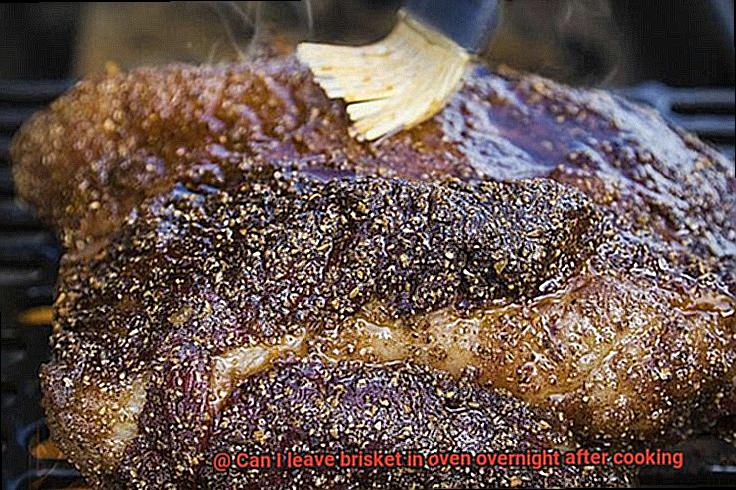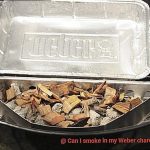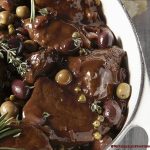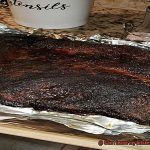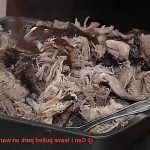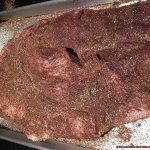Imagine this: you’ve spent hours slow-cooking a tantalizing brisket, filling your kitchen with the irresistible scent of mouthwatering flavors. And now, you’re left wondering, “Can I leave the brisket in the oven overnight after cooking?”
It’s a valid question. We all love convenience, especially when it comes to prepping for an event or getting ahead on meal prep. But before you tuck yourself into bed and dream of juicy slices of brisket, there are a few things you need to know.
In this blog post, we’re going to explore the safety and practical aspects of leaving your brisket in the oven overnight. We’ll give you all the information you need to make an informed decision about how to handle this delicious dilemma. So let’s dive in and discover the potential risks, benefits, and best practices that will keep your brisket both scrumptious and safe to serve.
Contents
Why Is It Not Recommended to Leave Brisket in the Oven Overnight?
Brisket, with its tantalizing tenderness and rich flavors, is a meaty masterpiece that deserves careful preparation. However, leaving brisket in the oven overnight can quickly turn this culinary delight into a disappointing disaster. In this blog post, we will explore the multitude of risks associated with leaving brisket in the oven overnight, including overcooking and drying out, food safety concerns, unsightly appearance, and wasteful energy consumption.
Overcooking and Drying Out:
Brisket’s journey from tough to tender is a delicate process that requires precise temperatures and cooking times. Leaving it in the oven for too long can result in tragic consequences. As the connective tissues gradually break down during cooking, the meat becomes moist and succulent. But if left unattended, the prolonged exposure to heat can transform that juicy tenderness into a dry, tough disappointment.
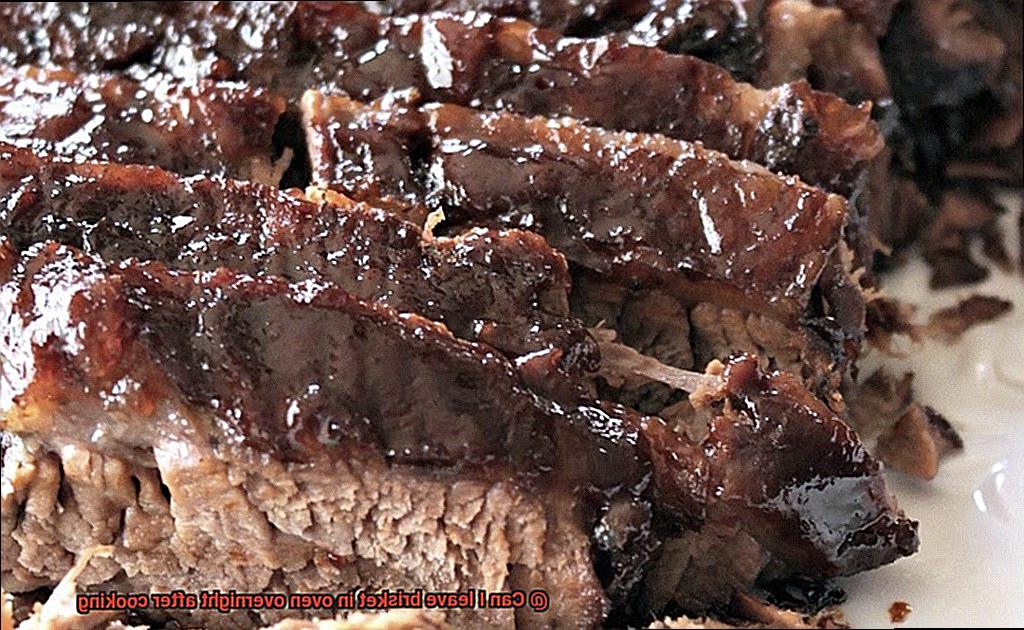
Food Safety Concerns:
Leaving cooked brisket at room temperature for an extended period creates a breeding ground for bacteria to thrive. Between 40°F (4°C) and 140°F (60°C), bacteria multiply rapidly, increasing the risk of foodborne illnesses. To protect your health and that of your guests, it is crucial to promptly refrigerate or cool down cooked brisket.
Appearance:
Imagine placing a beautifully marbled slab of brisket into the oven, only to find it blackened and charred come morning. Prolonged cooking time can cause the exterior of the brisket to become overly dark or even burnt, tarnishing its visual appeal. If you were hoping for a caramelized crust with a juicy interior, leaving it in the oven overnight is not the path to culinary perfection.
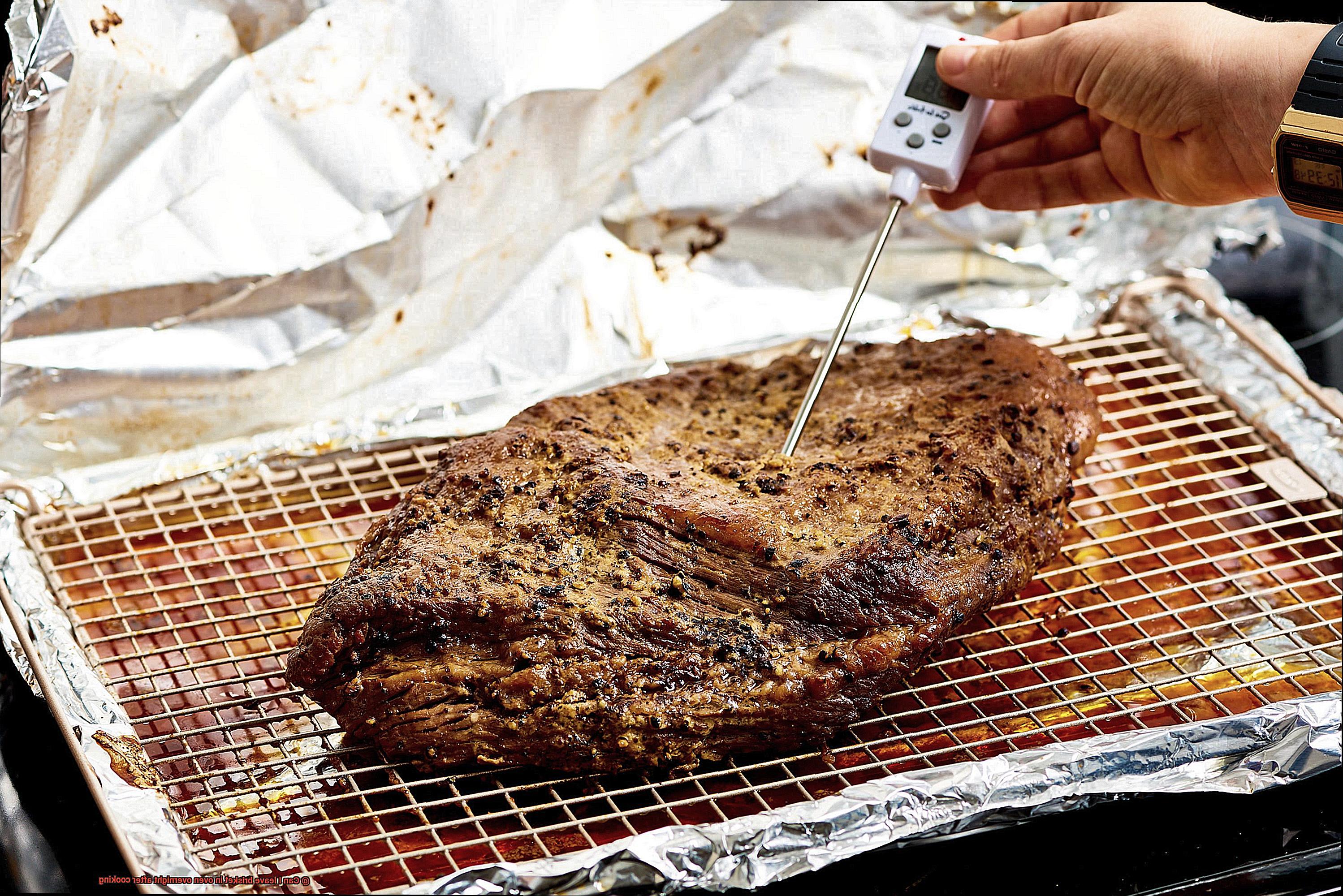
Wasteful Energy Consumption:
Picture your oven tirelessly churning out heat throughout the night, consuming excessive energy while you sleep. Leaving the oven running overnight not only wastes precious energy but also incurs unnecessary costs and contributes to environmental harm. To be mindful of both your wallet and the planet, it is best to plan ahead and allocate sufficient cooking time during the day.
Tips for Properly Handling Brisket:
- Remove the brisket from the oven when it reaches the desired temperature and allow it to rest for at least 30 minutes before slicing.
- If you need to keep the brisket warm, wrap it tightly in aluminum foil or butcher paper and store it in a preheated cooler.
- Refrigerate or cool down cooked brisket promptly to minimize the risk of bacterial growth.
- Store leftover brisket in an airtight container or wrap it tightly in plastic wrap or aluminum foil before refrigerating. Properly stored cooked brisket can last for up to four days.
- Freeze leftover brisket for longer storage, using freezer-safe packaging to prevent freezer burn. It can be frozen for up to three months.
How To Properly Cook Brisket
Look no further. In this comprehensive guide, we’ll take you through the steps to properly cook brisket, from selecting the right cut to monitoring the internal temperature. Get ready for a flavor explosion that will have everyone coming back for seconds.
Step 1: Choosing the Right Cut
To start your journey to brisket perfection, it’s crucial to choose the right cut of meat. Brisket comes in two parts: the flat-cut and the point-cut. The flat-cut is leaner and more uniform, while the point-cut boasts more marbling and flavor. For beginners, we recommend starting with the flat-cut as it is easier to work with and provides consistent results.
Step 2: Trim Excess Fat
Now that you have your brisket, it’s time to prepare it for cooking. Begin by trimming any excess fat from the surface of the meat. While some fat is necessary to keep the meat moist during cooking, too much can result in a greasy finished product. Aim to leave about a ¼ inch layer of fat on top of the brisket to enhance flavor and juiciness.
Step 3: Seasoning Sensation
Once your brisket is trimmed, it’s time to infuse it with mouthwatering flavors. Season generously with a dry rub or marinade of your choice. Experiment with spices like salt, pepper, garlic powder, onion powder, paprika, and brown sugar. Let your taste buds guide you as you create a flavor profile that suits your preferences.
Step 4: Low and Slow Cooking
The secret to tender and succulent brisket lies in low and slow cooking. If you’re using a smoker, maintain a consistent temperature of around 225-250°F (107-121°C). This slow cooking process allows the tough connective tissues in the meat to break down, resulting in melt-in-your-mouth tenderness. Smoke your brisket for several hours, depending on its size, until it reaches an internal temperature of 195-205°F (90-96°C).
If you’re roasting or slow cooking in the oven, preheat it to 275°F (135°C). Cook the brisket for about 1 hour per pound, or until it reaches that same internal temperature range. The low and slow cooking method ensures that the brisket is cooked evenly and becomes tender throughout.
Step 5: Temperature Check.
To guarantee perfection, always monitor the internal temperature of your brisket using a meat thermometer. This will prevent it from becoming overcooked or dry. Insert the thermometer into the thickest part of the meat without touching any bones. Remove the brisket from the heat source when it reaches the desired internal temperature.
How To Keep Cooked Brisket Warm for a Short Period of Time
You’ve spent hours grilling the perfect brisket, and now it’s time to savor your mouthwatering creation. But what if you’re not quite ready to serve? No need to fret. We have some tried and true methods to keep your cooked brisket warm for a short period of time, without sacrificing its flavor or tenderness. Whether you’re hosting a backyard barbecue or planning a picnic, these tips will ensure that your brisket stays warm and delicious until it’s time to dig in.
Wrap it up tight:
After grilling your brisket to perfection, tightly wrap it in aluminum foil or butcher paper. This creates a barrier, trapping the heat inside and keeping your brisket warm and juicy.
Utilize an insulated cooler:
An insulated cooler is a fantastic tool for keeping cooked brisket warm. Preheat the cooler by filling it with hot water, then drain it and place the wrapped brisket inside. Seal the cooler tightly and fill any empty spaces with towels or newspaper for extra insulation. Your brisket can stay warm in the cooler for up to 4 hours, giving you plenty of time to prepare other dishes or enjoy quality time with guests.
Warming drawer or oven:
If you have a warming drawer or oven with a low-temperature setting (around 170°F), this is another great option for keeping your cooked brisket warm. Place the wrapped brisket on a wire rack or in a shallow pan, cover it loosely with foil, and set it inside the warming drawer or oven. The low temperature will maintain the brisket’s heat without overcooking, ensuring it stays moist and tender for up to 2 hours.
Slow cooker magic:
No warming drawer or oven? No problem. A slow cooker works wonders for keeping your cooked brisket warm. Set it to its lowest setting and place the wrapped brisket inside. You can even add drippings or sauce to keep the meat moist and flavorful. Cover the slow cooker and let it work its magic, keeping your brisket warm for up to 2 hours while you attend to other party preparations.
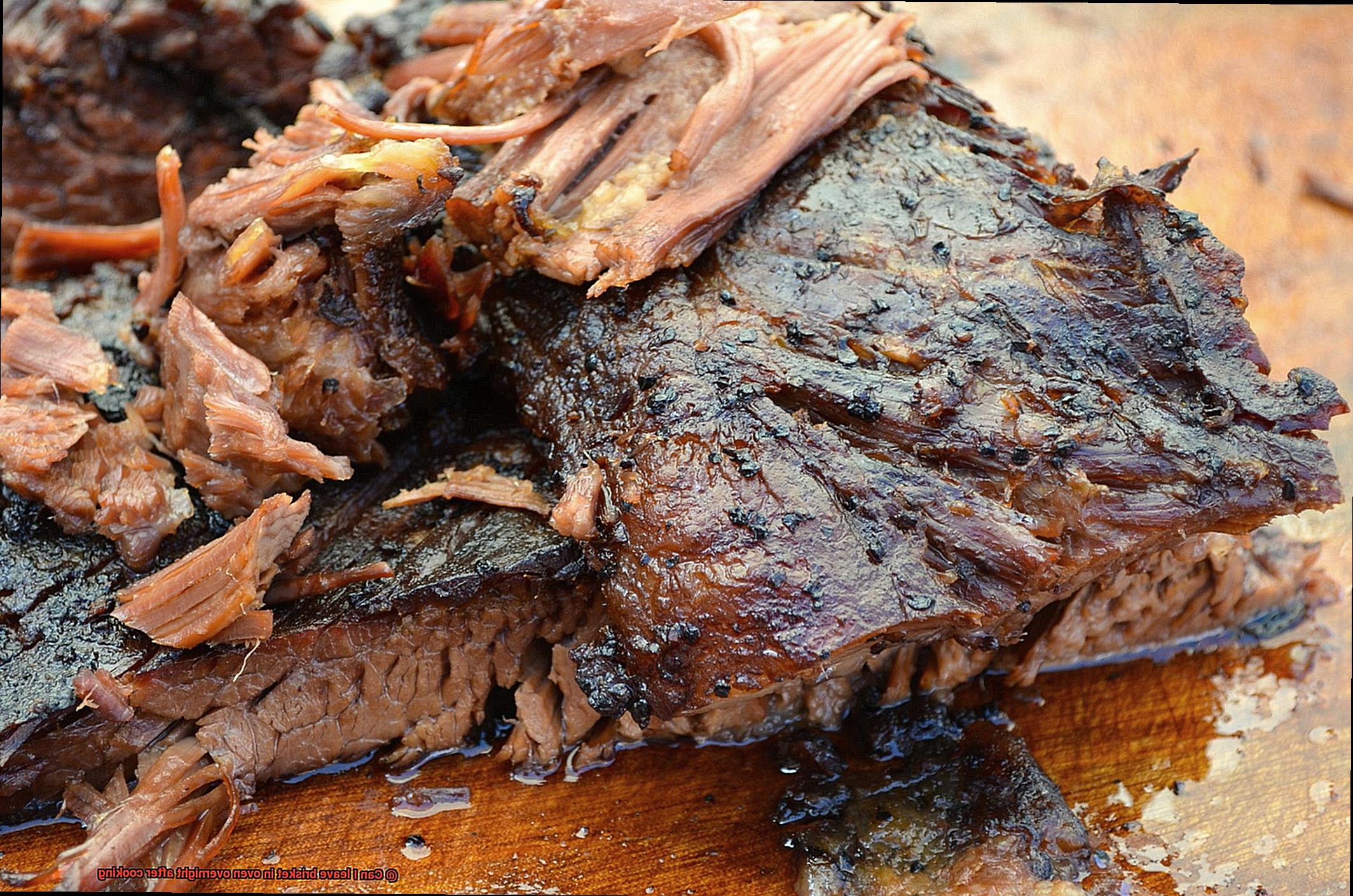
Safety first:
While these methods effectively keep your cooked brisket warm for a short period of time, never forget food safety. Don’t leave your brisket at room temperature for more than two hours, as it promotes bacterial growth. Always handle and store your brisket properly, following recommended guidelines for safe food storage.
The Two-Hour Rule for Perishable Foods
Picture this: you’ve just finished grilling a succulent, mouthwatering brisket that is perfectly tender and bursting with flavor. But what if unexpected delays occur, and your guests are running late? Don’t panic. We have you covered with invaluable tips to keep your brisket warm without compromising food safety. In this comprehensive guide, we will delve into the Two-Hour Rule for Perishable Foods and how it directly relates to storing and reheating cooked brisket. So, grab your apron and let’s embark on this journey to perfect brisket preservation.
The Two-Hour Rule:
The Two-Hour Rule stands as a crucial food safety guideline that advises against leaving perishable foods at room temperature for more than two hours. Bacteria thrive in the “danger zone” temperature range of 40°F to 140°F (4°C to 60°C), multiplying at an alarming rate. Unfortunately, our beloved brisket falls into the perishable category, making it susceptible to bacterial growth.
Storing Leftover Brisket:
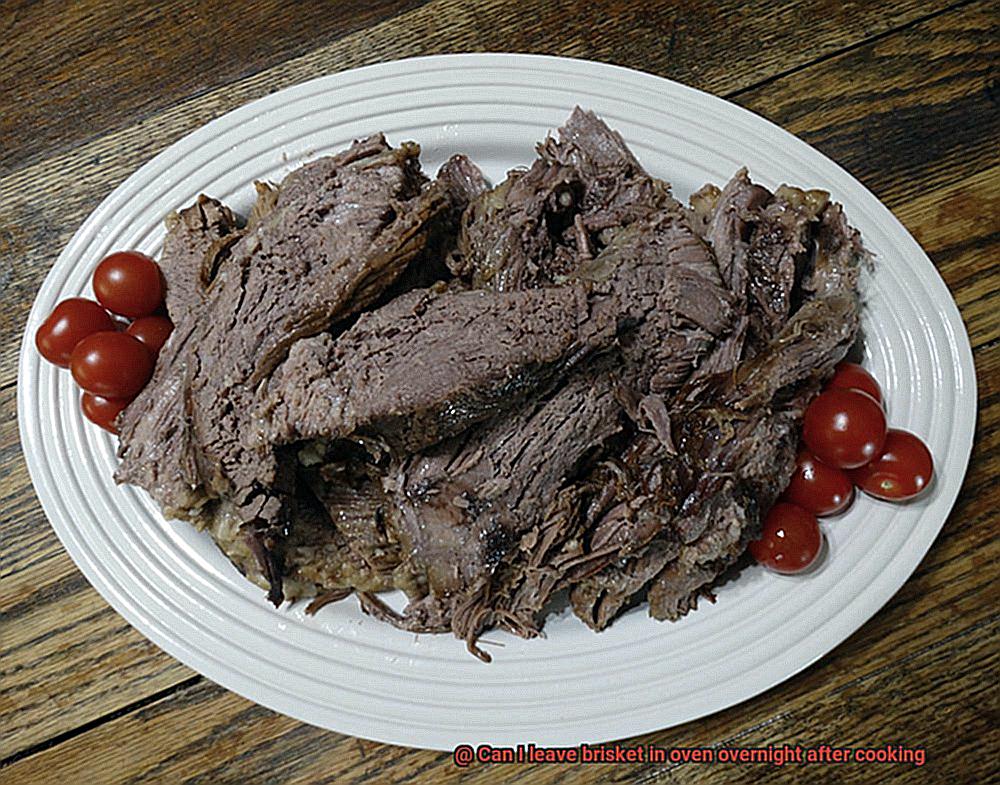
Ensuring the safety and quality of your leftover brisket hinges on proper storage techniques. Here are the essential steps:
- Refrigerate within two hours: Swiftly divide your brisket into smaller portions for faster cooling and refrigerate it within two hours of cooking. This swift action curbs bacterial growth.
- Airtight is the way to go: Shield your brisket from air exposure by using an airtight container or tightly wrapping it with aluminum foil or plastic wrap. This safeguard prevents freezer burn and preserves its delectable taste.
- Eat within 3-4 days: Properly stored leftover brisket can be safely consumed within 3-4 days. Beyond this timeframe, freezing becomes your best ally.
Freezing Cooked Brisket:
To extend the shelf life of your cooked brisket, harness the power of freezing. Follow these steps:
- Wrap it up: Embrace the art of securing your brisket by wrapping it tightly in freezer-safe packaging or placing it in airtight freezer bags. This protective cocoon ensures optimal quality and shields against freezer burn.
- Label and date: Don’t forget to label your packaged brisket with the date of freezing. This simple act serves as your compass for tracking its storage time.
- 3-month miracle: Relish in the knowledge that frozen brisket can be stored for up to three months without any compromise to its taste and texture.
Reheating Leftover Brisket:
When the time comes to reheat your leftover brisket, precision is key to eliminating any lingering bacteria. Familiarize yourself with these vital guidelines:
Cooling Down Cooked Brisket Before Refrigerating
Cooling down cooked brisket before refrigerating is not just a matter of preference; it is crucial for both food safety and maintaining the quality of the meat. No one wants a dry and rubbery brisket after putting in all that effort, right? So, let’s dive into the steps to ensure your brisket stays tender and delicious.
First and foremost, after removing the brisket from the oven, resist the temptation to immediately toss it in the fridge. Instead, let it rest at room temperature for about 30 minutes to an hour. This allows the surface temperature of the meat to drop and prevents condensation from forming when you do refrigerate it. Think of it as giving your brisket a well-deserved break before chilling out.
Once the brisket has had its rest, transfer it to a clean cutting board or platter and start slicing it into smaller pieces. Not only does this make serving easier later on, but it also helps with faster and more even cooling. By increasing the surface area exposed to air, you allow for quicker heat dissipation.
To speed up the cooling process even further, place your cut brisket pieces on a shallow baking sheet or tray. Spreading them out helps increase the surface area exposed to air, allowing for quicker cooling. Avoid stacking or tightly packing the pieces as this can trap heat and slow down the process. We want those delicious flavors to cool down, not stew in their own juices.
If you’re really in a hurry or just want to be extra cautious, use a fan to create airflow around the brisket. Alternatively, if you have a window nearby and the weather permits, place the baking sheet in front of an open window. The breeze will help cool down your meat even faster. It’s like giving your brisket a refreshing breeze after its hot journey.
Once your brisket has cooled down to room temperature, it’s time to store it in the fridge. Transfer it to airtight containers or wrap it tightly in foil before refrigerating. Remember, the goal here is to keep your brisket below 40°F (4°C) as quickly as possible to prevent bacterial growth. We want to keep those pesky bacteria away from our delicious barbecue masterpiece.
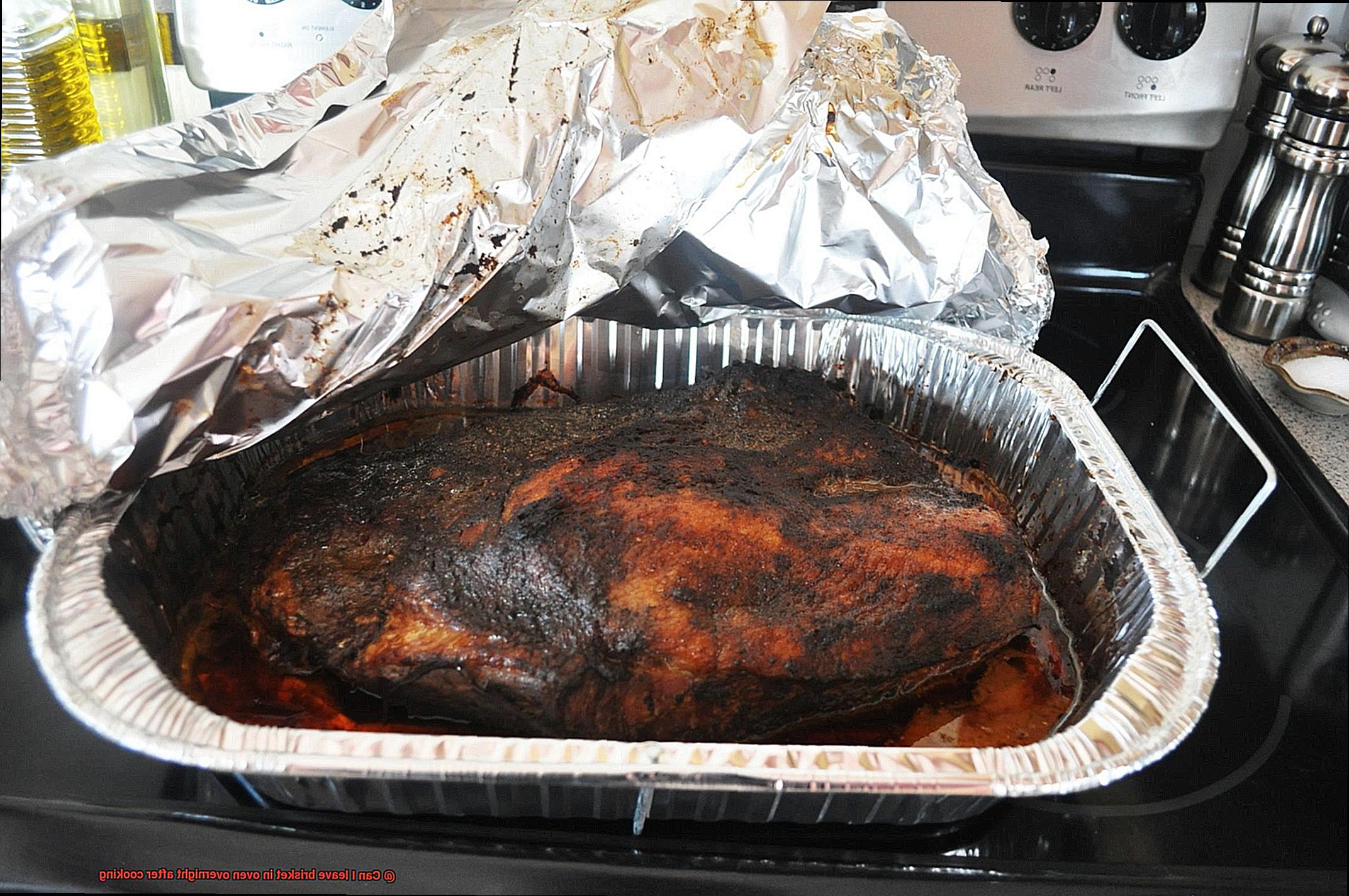
Storing Cooked Brisket in the Refrigerator
You’ve cooked up a mouthwatering brisket, and now you’re wondering how to store it in the refrigerator. Don’t worry – we’ve got you covered with this handy guide on storing cooked brisket.
Step 1: Let it cool down
Before you even think about storing that glorious brisket, let it cool down to room temperature. This step is crucial because it prevents condensation from forming inside the container, which can lead to moisture buildup and spoilage. Give your brisket a well-deserved break and let it cool for about 30 minutes to an hour.
Step 2: Slice and separate
Now that your brisket has cooled down, it’s time to slice and separate it into smaller portions. This not only makes reheating easier but also reduces the risk of bacteria growth. Remember to slice the brisket against the grain – this helps maintain its tenderness. Grab a sharp knife or an electric slicer, and let the magic happen.
Step 3: Store it right
When it comes to storing brisket in the refrigerator, an airtight container or tightly wrapped aluminum foil are your best friends. Place the sliced brisket into the container or wrap it tightly in foil, making sure there are no air gaps. This way, your brisket stays fresh and avoids any unwanted odors or flavors seeping in.
Step 4: Choose the perfect spot
Now that your brisket is securely stored, find its cozy spot in the refrigerator. For maximum shelf life, place it on one of the lower shelves where temperatures are cooler and more consistent. This ensures your brisket stays perfectly chilled for longer.
Step 5: Check for spoilage
While cooked brisket can typically be stored in the refrigerator for around 3-4 days, keep an eye out for any signs of spoilage. If you notice an off smell or a slimy texture, it’s best to bid farewell to your brisket to avoid any foodborne illnesses.
Bonus tip: Freezing for the long haul
If you want to store your brisket for a longer period, freezing is an option. However, keep in mind that freezing can affect the texture and tenderness of the meat. To freeze your cooked brisket, wrap it tightly in plastic wrap and then place it in a freezer-safe container or bag. Properly stored brisket can last for up to 2-3 months in the freezer.
When it’s time to reheat your stored brisket, remember to do so slowly and at a low temperature. This prevents drying out the meat and ensures it reheats evenly.
Freezing Leftover Brisket for Longer Storage
Freezing leftover brisket is the perfect way to ensure that you can savor it at your leisure. Here’s a step-by-step guide on how to freeze and reheat your brisket like a pro.
- Proper Packaging: To maintain the quality of your brisket, it’s crucial to package it correctly. Wrap the brisket tightly in plastic wrap or aluminum foil, or place it in airtight containers or freezer bags. This will prevent freezer burn and preserve its texture and flavor.
- Divide and Conquer: Before freezing, divide your brisket into smaller portions. This makes it easier to thaw later on and reduces waste. Separate the brisket into individual meal-sized portions or slice it into sandwich-ready pieces.
- Label with Love: Don’t forget to label your brisket packages with the date of freezing. This helps you keep track of how long it has been frozen and ensures safe consumption. No one wants to risk eating something that’s been in the freezer for ages.
- Thawing Time: When it’s time to enjoy your frozen brisket, properly thaw it. The best method is to thaw it in the refrigerator overnight. This slow thawing process retains the meat’s texture and flavor while ensuring it reaches a safe temperature throughout.
- Reheating Options: Once thawed, choose your preferred reheating method. Use a microwave, oven, or stovetop depending on convenience and preference. Just make sure the meat reaches an internal temperature of 165°F (74°C) to eliminate any potential bacteria.
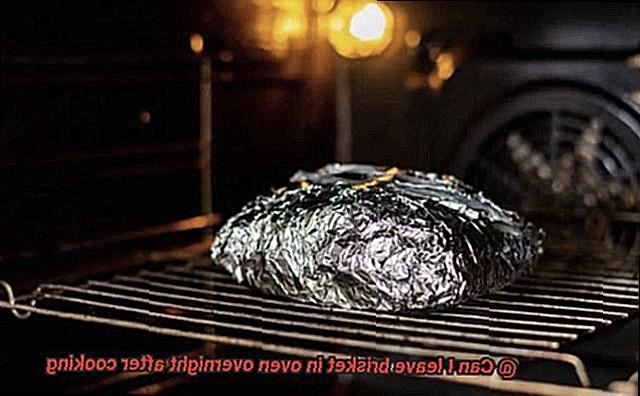
Remember, freezing and reheating leftover brisket may cause slight changes in texture and flavor. But if handled and reheated properly, it will still be a delicious treat worth savoring.
Reheating Leftover Brisket Safely
So, you’ve just indulged in a mouthwatering barbecue feast, and now you’re left with some delectable leftover brisket. Don’t let it go to waste. With the right techniques, you can reheat that succulent meat without sacrificing its tenderness and juiciness. In this comprehensive guide, we will walk you through safe methods to reheat your leftover brisket and keep it as delicious as ever.
Method 1: Oven Reheating
- Preheat your oven to 250°F (120°C) to ensure gentle and even reheating.
- Slice your brisket into portions for easier and faster reheating.
- Wrap each portion tightly in aluminum foil to retain its natural moisture and flavors.
- Place the wrapped brisket on a baking sheet and carefully transfer it into the preheated oven.
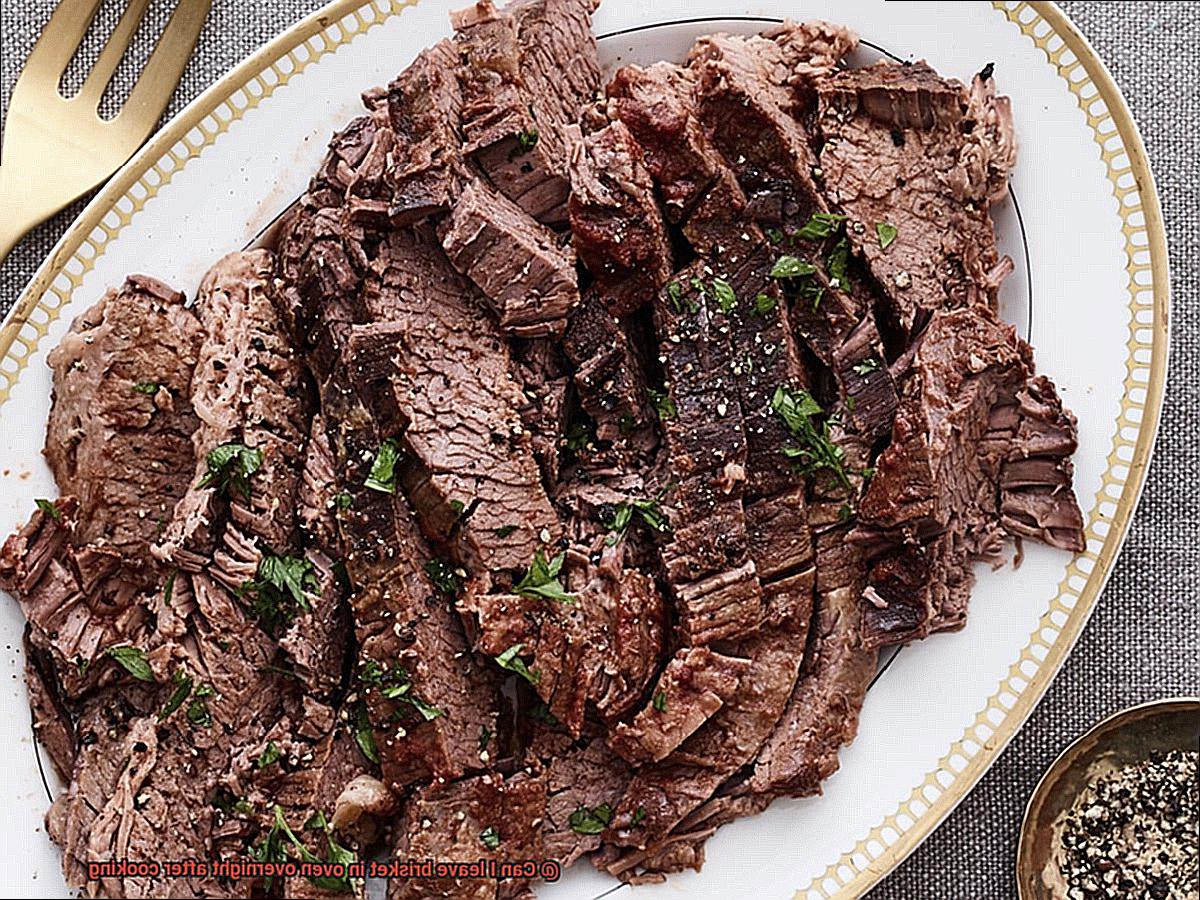
- Reheat until the internal temperature reaches at least 165°F (74°C) for optimal food safety.
- Remove from the oven, unwrap the tantalizing package, and savor every succulent bite.
Method 2: Slow Cooker Magic
- Slice your leftover brisket into portions, just as with the oven method.
- Place the portions in a slow cooker or crockpot.
- Add a small amount of liquid, such as broth or barbecue sauce, to enhance flavor and retain moisture during reheating.
- Set the slow cooker to low heat and let it work its magic for about 2-3 hours. Keep an eye on the internal temperature to ensure it reaches 165°F (74°C) for safe consumption.
- Once heated through, serve up those tender slices of brisket that are bursting with flavor.
Method 3: Stovetop Sizzle
- Slice your leftover brisket into portions again.
- Heat a skillet over medium heat and add a small amount of liquid, like broth or barbecue sauce, to prevent dryness and elevate the taste.
- Place the brisket portions in the skillet and cook for a few minutes on each side until heated through.
- Be vigilant not to overcook, as it can result in the loss of moisture and tenderness.
- Once warmed up to perfection, serve and relish the irresistible deliciousness.
Remember:
- Always store leftover brisket in the refrigerator within 2 hours of cooking to prevent bacterial growth.
- Discard any brisket left at room temperature for more than 2 hours to ensure food safety.
- Use a food thermometer to ensure the internal temperature reaches 165°F (74°C) for safe consumption.
- Feel free to add extra flavors through sauces or broths during reheating to enhance the overall taste.
Conclusion
Leaving brisket in the oven overnight after cooking is not recommended. While it may seem convenient to let it sit and continue cooking while you catch some Z’s, it can actually pose serious risks to both the quality and safety of your meat.
Firstly, leaving brisket in the oven for an extended period of time can result in overcooking. Brisket is a tough cut of meat that requires slow and low cooking to become tender and flavorful. However, if left in the oven for too long, it can become dry and stringy, losing all its juiciness and tenderness.
Moreover, there are food safety concerns associated with leaving cooked brisket out at room temperature for an extended period. Bacteria multiply rapidly between 40°F (4°C) and 140°F (60°C), which is known as the “danger zone.” Leaving cooked meat within this temperature range for more than two hours increases the risk of bacterial growth, potentially leading to foodborne illnesses.
To ensure both the taste and safety of your brisket, it’s best to follow proper handling guidelines. Once cooked, allow the brisket to rest for about 20 minutes before slicing it. After that, promptly refrigerate any leftovers within two hours to prevent bacterial growth.
In conclusion, while it may be tempting to leave your brisket in the oven overnight after cooking, it is not advisable. Overcooking can ruin its texture and flavor, while leaving it at room temperature poses potential health risks.
You may also like:

